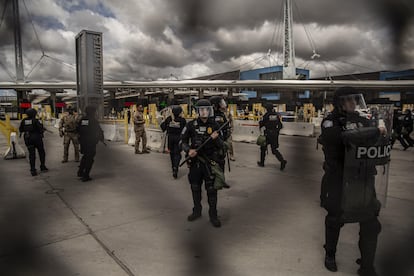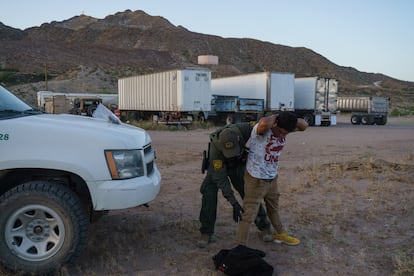Pressure on Mexico’s US border whipped up by imminent end to Title 42
Mexico’s foreign minister says a sharp increase in the flow of migrants is expected, as they desperately seek to reach the United States

Following the announcement that Title 42 is to lapse, Mexico is bracing for an influx of migrants seeking to enter the United States. On 11 May, the U.S. intends to end its Covid-19 public health emergency and, with it, the controversial measure that allowed the country to quickly turn away migrants crossing its southern border illegally. For the past three years, Mexico has been the waiting room for all those ejected by its neighbor in the north. Now, with Title 42 coming to an end, it’s not as if the gates to the U.S. are suddenly going to spring open – yet Mexico’s foreign minister, Marcelo Ebrard, says a sharp rise in the flow of migrants is expected, as they desperately seek to make it into the U.S.
The impact of the imminent end to Title 42 has been felt right away in Mexico. In Tapachula, on the border with Guatemala, there has been renewed fighting between migrants eager to push through their paperwork so they can continue their journey towards the U.S. In Mexico City, a regular stop on the way to the States, hostels are emptying as migrants rush to the border. “They’re so desperate to reach [the U.S.] that people who had paperwork in process or were waiting for news on their asylum request have given up on that in a bid to get there as soon as possible,” explains Gabriela Hernández, the manager of the Tochán hostel in the Mexican capital. In Ciudad Juárez, U.S. authorities estimate that around 12,000 people are waiting until Thursday to cross the border into El Paso, whose mayor, Oscar Leeser, has declared a state of emergency. According to Leeser, a further 3,000 migrants could join that group.
“In recent days, we’ve seen a major flow of migrants on the back of a lie,” Ebrard told a press briefing on Friday. “People from Venezuela and Central America are told, ‘Hurry up and get to the United States, because on 11 May they’re going to remove Title 42.’” Talk of a clear path into the U.S. is false, the minister stresses, because the country also has other legal provisions at its disposal.

Title 42 is an old directive resuscitated by the former U.S. president, Donald Trump, to contain illegal immigration under the pretext of the pandemic healthcare crisis. Its end was only a matter of time. Over the past three years, it has operated alongside Title 8. For example, in December last year, U.S. Customs and Border Protection (CBP) detained 251,487 illegal migrants, of which around 50,000 were sent back to Mexico under Title 42 – and some 202,000 were returned to their countries of origin under Title 8. The measure has been in place since 1995, and carries a penalty: for a period of five years, the foreign national is barred from re-entry to the U.S., not even for tourism or for purposes of family reunification. This is the measure that the country will continue using.
“There’s a misconception among the migrant population that the end of Title 42 is going to pave the way for them to enter the U.S. and begin the process of seeking asylum, but it’s quite the contrary,” says Inés Barrios, the academic coordinator at Mexico’s Colegio de la Frontera Norte (College of the Northern Border), which specializes in research on border issues. “After 11 May, any person who tries to enter illegally will be deported under Title 8.”
To illustrate the U.S.’s plans, Barrios points to the 1,500 additional soldiers that President Joe Biden’s administration has sent to the southern border to contain the arrival of thousands of migrants. “In preparation for the new situation, what we’re seeing is a process of militarization on the part of the United States,” says Barrios, who has a doctorate in migration studies. “And, when it comes to Mexico, we’re not seeing any clear action to respond to the arrival of these migrants.”

The change in the U.S.’s immigration policy comes at a delicate time. Mexico’s National Institute of Migration (INAMI) is reeling from the fire that ripped through one of its processing centers in Ciudad Juárez at the end of March, leaving 41 migrants dead. The institute’s director, Francisco Garduño, is one of a dozen federal civil servants now facing charges over the incident. With INAMI in turmoil, Mexico must adjust to the rising migratory strain within its borders and to pressure from the administration in the U.S., where immigration is now a critical issue for the Democrats.
Andrés Manuel López Obrador’s Mexican government has agreed to continue accepting Venezuelans, Cubans, Haitians and Nicaraguans, who instead of being deported to their own countries, will be returned to Mexican soil. However, there is one change to this process. Title 42 allowed migrants as many illegal border-crossing attempts as they wanted – there were no consequences if they were expelled to Mexico. Now, if migrants of these nationalities are turned away, they cannot seek legal entry for five years. That leaves them with two options, says Barrios. “There will be an increase in the processes of irregular and clandestine routes, with migrants forced to hire a trafficker, increasing their vulnerability,” she says. Alternatively, they will face a long-term wait in a country that has become a pressure cooker. In 2022, there were a record 120,000 asylum requests in Mexico.
The sun offers no let-up in Ciudad Juárez. Someone has spread a rumor that gate 36 of the wall separating Mexico from El Paso is open. Hundreds of migrants set out on the almost two-hour walk that separates the gate from the city center. Among the groups making the journey, there are pregnant women, children and babies in prams. Most don’t have water or anything that can protect them from the sun, but the hope of crossing the border beats all that. There’s no way through, though, so the migrants are forced to turn around and carry on waiting, sleeping in hostels, begging for money, cleaning car windows. That’s how thousands of people in Mexico are living, made dizzy by misinformation and uncertainty as they try to get an appointment on the CBP One app, which the U.S. authorities have made available to people seeking asylum in the States. This vulnerable environment, in which even a WhatsApp can provoke a stampede to the border, has been exacerbated by the end of Title 42.
Sign up for our weekly newsletter to get more English-language news coverage from EL PAÍS USA Edition
Tu suscripción se está usando en otro dispositivo
¿Quieres añadir otro usuario a tu suscripción?
Si continúas leyendo en este dispositivo, no se podrá leer en el otro.
FlechaTu suscripción se está usando en otro dispositivo y solo puedes acceder a EL PAÍS desde un dispositivo a la vez.
Si quieres compartir tu cuenta, cambia tu suscripción a la modalidad Premium, así podrás añadir otro usuario. Cada uno accederá con su propia cuenta de email, lo que os permitirá personalizar vuestra experiencia en EL PAÍS.
¿Tienes una suscripción de empresa? Accede aquí para contratar más cuentas.
En el caso de no saber quién está usando tu cuenta, te recomendamos cambiar tu contraseña aquí.
Si decides continuar compartiendo tu cuenta, este mensaje se mostrará en tu dispositivo y en el de la otra persona que está usando tu cuenta de forma indefinida, afectando a tu experiencia de lectura. Puedes consultar aquí los términos y condiciones de la suscripción digital.
More information
Archived In
Últimas noticias
$3,000 and a plane ticket: The United States increases incentives for migrants to self-deport before the end of the year
Charles Dubouloz, mountaineering star, retires at 36 with a farewell tour inspired by Walter Bonatti
From the White House to diplomatic gifts: Lego wins over adult fans, brick by brick
Kate Winslet makes her directorial debut: ‘There aren’t more female directors because we’re busy raising children’
Most viewed
- Families demand repatriation of bodies of Colombians who died in Ukraine: ‘This war is a slaughterhouse for foreigners’
- The low-cost creative revolution: How technology is making art accessible to everyone
- Liset Menéndez de la Prida, neuroscientist: ‘It’s not normal to constantly seek pleasure; it’s important to be bored, to be calm’
- Christian Louboutin: ‘Young people don’t want to be like their parents. And if their parents wear sneakers, they’re going to look for something else’
- Christmas loses its festive spirit: ICE fears cast shadow over religious celebrations











































